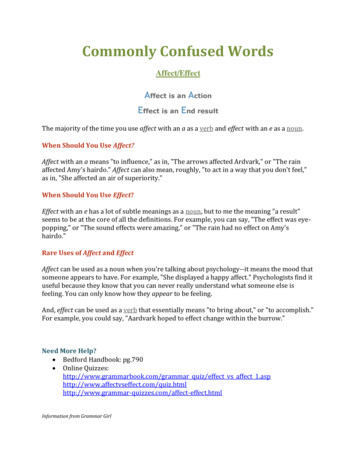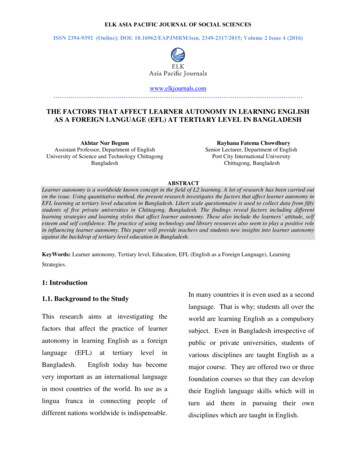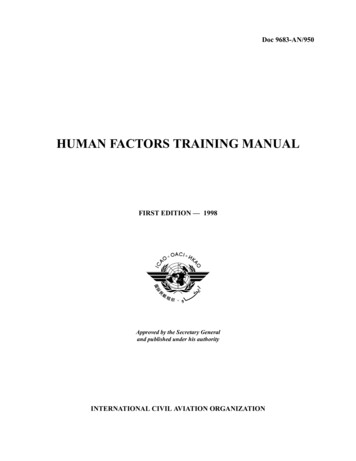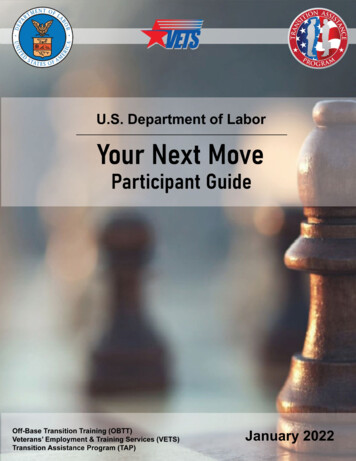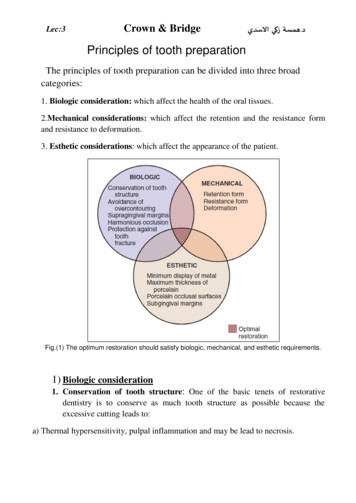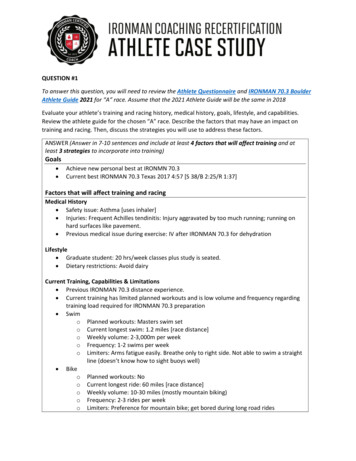
Transcription
QUESTION #1To answer this question, you will need to review the Athlete Questionnaire and IRONMAN 70.3 BoulderAthlete Guide 2021 for “A” race. Assume that the 2021 Athlete Guide will be the same in 2018Evaluate your athlete’s training and racing history, medical history, goals, lifestyle, and capabilities.Review the athlete guide for the chosen “A” race. Describe the factors that may have an impact ontraining and racing. Then, discuss the strategies you will use to address these factors.ANSWER (Answer in 7-10 sentences and include at least 4 factors that will affect training and atleast 3 strategies to incorporate into training)Goals Achieve new personal best at IRONMN 70.3Current best IRONMAN 70.3 Texas 2017 4:57 [S 38/B 2:25/R 1:37]Factors that will affect training and racingMedical History Safety issue: Asthma [uses inhaler] Injuries: Frequent Achilles tendinitis: Injury aggravated by too much running; running onhard surfaces like pavement. Previous medical issue during exercise: IV after IRONMAN 70.3 for dehydrationLifestyle Graduate student: 20 hrs/week classes plus study is seated. Dietary restrictions: Avoid dairyCurrent Training, Capabilities & Limitations Previous IRONMAN 70.3 distance experience. Current training has limited planned workouts and is low volume and frequency regardingtraining load required for IRONMAN 70.3 preparation Swimo Planned workouts: Masters swim seto Current longest swim: 1.2 miles [race distance]o Weekly volume: 2-3,000m per weeko Frequency: 1-2 swims per weeko Limiters: Arms fatigue easily. Breathe only to right side. Not able to swim a straightline (doesn’t know how to sight buoys well) Bikeo Planned workouts: Noo Current longest ride: 60 miles [race distance]o Weekly volume: 10-30 miles (mostly mountain biking)o Frequency: 2-3 rides per weeko Limiters: Preference for mountain bike; get bored during long road rides
RunoooooPlanned workouts: NoCurrent longest run: 13.1 miles [race distance]Weekly volume: 10-15 milesFrequency: 1-2 runs per weekLimiters: Pacing. Tend to push too hard. Frequent Achilles injuries force Ken to stoprunning for long periods of timeStrategies to incorporate into training to address above factorsMedical History Safety issue: Asthma [uses inhaler]o Identify Asthma management plan and prescribed use of inhaler from Doctoro Identify and specific asthma triggerso Incorporate extended warm ups in training to minimise impact of asthma Injuries: Frequent Achilles tendinitis:o Encourage running analysis to identify potential biomechanical causes of Achillestendinitiso Ongoing athlete monitoring for Achilles tendinitis symptoms Injury aggravated by too much running; running on hard surfaces like pavement.o Periodisation of run training load applying principles of progressive overload andrecoveryo Minimise running on hard surfaces Previous medical issue during exercise: IV after IRONMAN 70.3 for dehydrationo Implementation of hydration strategies for training and racing.o Incorporate pre-post session weighing to understand sweat rates.Lifestyle Graduate student: 20 hrs/week classes plus study is seated.o Complete screening for muscle imbalances and corrective exercises as required Dietary restrictions: Avoid dairyo Identify dairy alternativesCurrent Training, Capabilities & Limitations Previous IRONMAN 70.3 distance experience. Current training has limited planned workouts and is low volume and frequency regardingtraining load required for IRONMAN 70.3 preparation Swimo Planned workouts: Masters swim seto Current longest swim: 1.2 miles [race distance]o Weekly volume: 2-3,000m per weeko Frequency: 1-2 swims per week§ Periodisation of swim training load applying principles of progressiveoverload and recovery to build towards longer and more frequent swimsessions in preparation for 1.2 mile race distance
o Bikeooooo RunoooooLimiters: Arms fatigue easily. Breathe only to right side. Not able to swim a straightline (doesn’t know how to sight buoys well)§ Incorporate open water swim skills into program: including bilateralbreathing, straight line swimming and sighting skillsPlanned workouts: NoCurrent longest ride: 60 miles [race distance]Weekly volume: 10-30 miles (mostly mountain biking)Frequency: 2-3 rides per week§ Periodisation of bike training load applying principles of progressiveoverload and recovery to build towards higher weekly volume bike sessionsin preparation for 60 mile race distanceLimiters: Preference for mountain bike; get bored during long road rides.§ Encourage bike fit for road bike§ Provide targeted mix of training between road and mountain biking todevelop road skills and enhance motivation for trainingPlanned workouts: NoCurrent longest run: 13.1 miles [race distance]Weekly volume: 10-15 milesFrequency: 1-2 runs per week§ Periodisation of bike training load applying principles of progressiveoverload and recovery to build towards higher weekly volume andfrequency of run sessions in preparation for 13.1 mile race distanceLimiters: Pacing. Tend to push too hard. Frequent Achilles injuries force Ken to stoprunning for long periods of time§ Ongoing athlete monitoring for Achilles tendinitis symptoms§ Clearly defined session plans identifying appropriate pacing/intensity ofeffort and recovery§ Minimise running on hard surfaces – gradually build exposure to hardsurfaces
QUESTION #2Create a weekly training schedule for the first two (2) microcycles in the Pre-Competition subphase forthe athlete’s training plan for the athlete’s “A” race.Use the sample Novice IRONMAN 70.3 20 Week Training Plan, Athlete Questionnaire and the 2017IRONMAN 70.3 Boulder Athlete Guide as a guide for the following information required in the schedule:1. Identify the average training intensity zone and goals for the microcycle2. Create a schedule of training sessions3. For each training session enter the discipline (swim, bike, run, strength), the duration and theintensity of the session (by zones) Note: S Swim ; B Bike; R Run; St Strength4. For each discipline, identify the key high intensity session with an H; Identify the key endurancesession with an E5. Identify the strength and conditioning phase as either stability/endurance (S&E); strength (MS);Power (P); Maintenance (M)Microcycle #1Phase: Pre-CompetitionMicrocycle Average Training Intensity: Zone 3-4Microcycle Goals: practice race pacing and race preparation Session 1SWIMopen waterskills00:30[2] skillsRUN01:00[3-4]* HSWIM01:00[2] – EMasters SquadRUN01:30[2-3] ESWIM01:00[3-4]* HMasters SquadSession 2STRENGTH00:30[M]Session 3BIKE01:00[3-4]* HBIKE01:00[2] ENDSaturdaySundayBIKE03:00[2-3] ENDDAY OFFRUN - Brick00:15[3]
Microcycle #2Phase: Pre-CompetitionMicrocycle Average Training Intensity: Zone 3-4Microcycle Goals: practice race pacing and race preparation Session 1SWIMopen waterskills00:30[2] skillsRUN01:15[3-4]* HSWIM01:00[2] – EMasters SquadRUN01:30[2-3] ESWIM01:00[3-4]* HMasters SquadSession 2STRENGTH00:30[M]BIKE01:15[3-4]* HBIKE01:00[2] ENDSaturdaySundayBIKE03:30[2-3] ENDRUN - Brick00:15[3]DAY OFFSession 3Enter the total number of hours and session for each weekWeek 1Week 2# Hours# Sessions# Hours# trength0:3010:301Total10:451011:4510Please state at least three changes you are making and reasons for the changes to the sample NoviceIRONMAN 70.3 20 Week Training Plan. (1-2 sentences each)1.2.3.Included Day off [Sat] as per availability and fits within identified 6-12 hr/week trainingIncluded extra swim session to practice open water skills - straight line swimming and sightingidentified as limiterChanged focus of STRENGTH session objective from power to maintenance.
4.5.6.Decreased RUN volume and sessions to help with injury prevention/management [Achillestendinitis]Increased BIKE sessions to minimize effects of reversibility and increase road bike ridingProvided greater recovery between identified HARD training sessions
QUESTION #3Using the athlete’s Bike Assessment Form, write a 75 minute bike workout as a key high intensitysession for your athlete for the Pre-Competition subphase for their “A” race.Include warm up, main set and cool down with appropriate intensities for the training phase along withtwo drills. Address considerations from biking experience, lifestyle and any past injuries (1 sentenceeach). State any assumptions that you are making when writing the workout.Subphase:Pre-CompetitionDuration:75 minutes using indoor trainerIntensity:Goal:3-4Improve cardiovascular fitness and lactate toleranceHigh Intensity session focusing on cadenceMaximum efforts of high quality workWarm Up:15 minutes total [Zone 1-2 147 bpm]5 minutes Zone: 1-2 spin3 minutes “Single Leg Drill” – focus on no slippage of stroke 1 x 15 sec each leg 1 x 30 sec each leg 1 x 45 sec each leg3 minutes “Single Leg Drill” – focus on cadence 90 rpm 1 x 15 sec each leg 1 x 30 sec each leg 1 x 45 sec each leg4 minutes Zone: 1-2 spinMain Set:4 x 30 sec Zone 4 @ 115 rpm then 30 sec recovery Zone 24 x 60 sec Zone 4 @ 90-100 rpm then 60 sec recovery Zone 24 x 2 min Zone 4 @ 90-100 rpm then 2 min recovery Zone 210 min steady state Zone 32 x 2 min Zone 4 @ 90-100 rpm then 90 sec recovery Zone 2Zone 2 140-147 bpmZone 4 157-164 bpmCool DownConsiderations:15 minutes [Zone 1-2 147 bpm]Zone: 1-2 spin – focus on cadence1. Biking Experience: Limited road bike experience
Boredom of long road bike rides2. Lifestyle: Fits training availability and equipment availability3. Past injuries: No loading to impact Achilles tendinitisAssumptions:1. Ken has completed a periodised training program that has progressed throughGeneral Preparation and Specific Preparation sub phases prior to commencingthis Pre-Competition session2. Ken has a good understanding of, and feedback [HR] to ensure accuracy ofexercise intensity3. Ken has a good understanding of, and instant feedback on cadenceWhy did you choose those drills? (1-2 sentences each)1. Drill #1: “Single Leg Drill” – focus on no slippage of stroke Develop equal power output from both legs [identified in Bike assessment 45% left / 55% right]2. Drill #2: “Single Leg Drill” – focus on cadence 90 rpm Develop higher cadence [identified in Bike assessment currently 72rpm]
QUESTION #4:At your athlete’s last IRONMAN 70.3 race on an exceptionally hot and humid day, the athlete becameseverely dehydrated and had to be treated in the medical tent afterwards.When you asked him about what happened, he said that he only drank 1 bottle of sports drink (25 gcarbohydrates per bottle) during the bike because he forgot to drink and skipped most of the run aidstations. He said that he did remember to eat a gel (25 g carbohydrates per gel) every 30 minutes for thebike and run.What changes would you make to his current fueling and hydration plan and why? (2-3 sentences)1. drank 1 bottle of sports drink (25 g carbohydrates per bottle) during the bike Actual fluid intake 600ml Based on sweat rate Target fluid intake 1–1.2 liter/hour [250 – 300ml every 15 minutes]2. skipped most of the run aid stations. Actual fluid intake ? Based on sweat rate Target fluid intake 1–1.2 liter/hour [250 – 300ml every 15 minutes]3. eat a gel (25 g carbohydrates per gel) every 30 minutes for the bike and run. Actual CHO intake 50g/hr Target CHO intake is 70-90 g/hrSee Fueling and Hydration Strategy belowHow can the athlete monitor his hydration status during and after training? (2-3 sentences)There are 2 simple methods an athlete can use to monitor hydration status:1. Body weight [Sweat Rate] To monitor hydration status using body weight, athletes should weigh themselves inminimal clothing pre and post training sessions – each 1 kg is equivalent to 1 litre offluid loss2. Urine colour To monitor hydration status using urine colour, athletes should monitor the colour oftheir urine regularly if their urine colour is more like apple juice than lemonadedehydration is likely
What strategies will you have your athlete practice to stay hydrated in the future? (2-3 sentences)See Fuelling and Hydration Strategy belowFueling and Hydration StrategyBefore raceTimeCarbs (grams)Fluid (oz/ml)Sodium (mg)2-4 hours2g/kg (mainly liquid andeasily digestedcarbohydrates3–5 ml/kg450–1120 mg per liter (or32 fl. oz.) (sports drink,small amounts of saltyfood)Ken target 140g30 min15–30 gKen target 210 - 350ml250-300ml or ad lib450–1120 mg per liter (or32 fl. oz.) (sports drink,small amounts of saltyfood)Sports drink/gelsDuring raceAfter raceSwimN/AN/AN/AT1250ml Sports drink 14gCHO200ml50mgBike70-90 g/hr1–1.2 liter/hour.700-1000 mg/hrSports drinks and gel250 – 300ml every 15minSports drinksT2250ml Sports drink 14gCHO200ml50mgRun60-75 g/hr1–1.2 liter/hour.700-1000 mg/hrSports drinks and gel250 – 300ml every 15minSports drinks1–1.2 gm kg/hr1.5 liter/kg lostKen target 70-85 gNeed to compare pre andpost race weightConsume foods/fluidsthat contain sodium tofacilitate rehydrationWithin 60minutes
To answer this question, you will need to review the Athlete Questionnaire and IRONMAN 70.3 Boulder Athlete Guide 2021 for "A" race. Assume that the 2021 Athlete Guide will be the same in 2018 Evaluate your athlete's training and racing history, medical history, goals, lifestyle, and capabilities.

